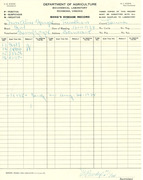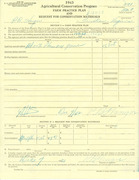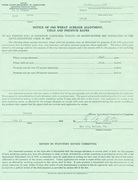Agriculture
The 1930s saw a sharp increase in the number of cases of brucellosis affecting both cattle and humans in the United States. Brucellosis, also know as Bang’s Disease, affects reproduction in cattle, leading to premature calving, abortion, difficulty breeding, and often sterility. Brucellosis is also contagious to humans, spread by consumption of milk from infected cows. In humans, the disease was commonly known as “undulant fever” during the Great Depression. A person suffering from undulant fever could become septic, accompanied by fever, sweating, and joint and muscle pain. During the 1930s, the treatment for brucellosis in humans was relatively ineffective, and it was not until the late 1940s that antibiotic treatments for brucellosis began to be developed (effectiveness of treatment was still unreliable until the 1960s). As part of the New Deal, the United States Department of Agriculture began a campaign to reduce cattle production in order to raise prices of beef and milk, and the USDA saw this initiative as an opportunity to eradicate brucellosip.
In 1934, the government established the Cooperative State Federal Brucellosis Eradication Program through which herds of cattle were tested for brucellosis, and those infected were slaughtered.This document is a record of the results of brucellosis testing in Alice Hanger’s cattle herd in 1934. The results show that none of her thirty-four cattle tested positive, and only one was marked suspicious, which was very good for the time. On average, three to four cattle in a herd this size would have tested positive for brucellosis in the United States in 1934.
In 1935, Congress passed the Soil Conservation and Domestic Allotment Act to combat the effects of erosion that had led to the Dust Bowl and exacerbated the effects of the Great Depression on farmers. The Act created the Agricultural Conservation Program which gave farmers soil-building payments to switch from surplus crops to crops that would deter erosion, such as legumes and grasses. In this manner, the Agricultural Conservation Program reduced oversupply of surplus crops and encouraged more stable farm practices.
The Federal Crop Insurance Corporation (FCIC) was created by Congress in 1938 though the Federal Crop Insurance Act. The FCIC was created to help farmers recover from the effects of the Great Depression and the Dust Bowl by offering insurance on crops to protect farmers against periods of low yield or low returns. The program persisted through the end of the Great Depression and is still in existence today. This document lists the quantity of expected crops that were eligible for insurance on Pallison Hanger's farm in 1943.


